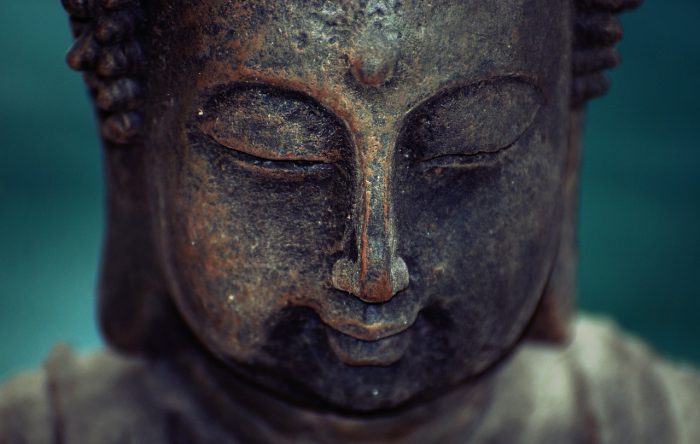The aim is to observe these sensations with equanimity, without reacting to them. Through this process, practitioners seek to develop insight into the impermanent, unlabelled, and selfless nature of existence, as taught in Buddhist philosophy.
These retreats are open to people of all backgrounds, religions, and beliefs, with participants expected to embrace the guidelines and teachings of the retreat during their stay.
I arrived at the retreat open to the teachings and schedule but quite naïve too! I was expecting a smaller setting and did not expect the 10 hours of meditation a day, with a wake-up call at 4 a.m.
We began observing Noble Silence from the evening of day one before the first meditative sitting in the hall. In some ways, all those silent, moving humans, walking around a set area of the property, unable to leave or move outside that area, mostly looking at their feet, felt a bit like a prison. A golden prison, though, set in beautiful nature with some tasty vegetarian food cooked with love by volunteers.
As I sat in my first meditations, my mind was so busy…wandering almost non-stop, thinking about all the things I had to do back home, the different conversations I’d had that day, the kids’ activities I was missing, and wondering why I was there. I had thoughts of leaving the retreat on day one, thinking, “This is such a waste of time…I don’t like sitting all day…I have so many more productive things to do.” Fortunately, I am aware of my mind and its patterns and usually don’t let those impulsive thoughts drive the show. So, I observed, laughed a bit at my mind, and brought presence to living moment by moment.
I felt a deep solitude and missed my family a lot, like a little homesickness on day one. I was resisting the whole experience. Again, I usually don’t let emotional reactions lead the show, so I observed those with openness and tenderness, held the part of me that wanted to leave, and opened again to the experience.
As I sat in meditation, I gradually brought my mind more in focus to the breath and then to body sensations. In moments of intense sensations, I managed to observe them without judging them as pleasant or unpleasant, allowing a sense of deep relaxation to come through. By stopping my resistance, I observed the sensations’ essence: a vibration that seemed to expand beyond my body, just a sense of floating in a vibrational source.
Throughout those sittings, a lot of memories, people, and beautiful visions or visuals showed up, some moments of my life—some big, some small—some relationships’ failures, some beautiful moments like the birth of my sons.
The visuals I had in some sittings were absolutely stunning—beautiful animals, nature, shapes, and colours. I am not sure exactly what they meant or were; overall, I felt a deep cleansing and release of many of my unresourceful patterns.
I felt my samskaras (life’s imprints) clearing and cleansing—a purification.
Here are the 10 beautiful lessons I took from the whole experience and brought home:
Lesson 1: Screen Time Pollutes the Mind.
Even though I’m conscious of my screen time, I habitually reach for my phone at the first sign of boredom. Being phone-free for 10 days was a blessing and liberation in that golden prison-like setup. Vipassana purifies the mind layer by layer, and my first layer was full of the social media videos and movies I’d watched. So, lesson number one is to bring back healthy screen habits:
>> No phone in the bedroom—buy a normal alarm clock.
>> Sundays will be screen-free days.
>> Limit social media on my phone to 45 minutes a day (including posting for my business).
Lesson 2: The Importance of Stopping and Reflecting.
In our busy lives, it’s impossible to reflect and gain clarity without taking time to pause. Whether through a retreat, hiring a coach, or simply not using our phones on Sundays, it’s important to stop and reflect. During those 10 days, I reviewed my entire life, the little and bigger traumas, the moments of joy, and released another big layer of what needed to be released.
Lesson 3: The Importance of Boredom.
Growth couldn’t have happened without the opportunity to be bored. No phone, no one to talk to, no entertainment, no distractions—just time to explore and release. Boredom is a gift. It’s sad to see people unable to embrace boredom, which is just time with oneself. Being, not doing. It’s uncomfortable at first, but it fosters introspection, growth, and creativity. During my daily silent walks, I found myself writing new articles and songs in my head, eager to put them on paper.
Lesson 4: It’s Okay to Be Alone. Silence is Golden.
In some ways, we were together and alone during the retreat. We were together yet unable to communicate. In many ways, it felt similar to real life, where conversations often remain superficial, and loneliness can persist in a crowd. Being alone was part of the learning. Many of my clients resist being alone, labeling it as something bad, but alone doesn’t have to be lonely. Silence was rejuvenating—no superficial conversation, no unnecessary mind chattering from interactions.
Lesson 5: It’s Okay Not to Be Perfect.
As a recovering perfectionist, I observed that I let go of a lot of my perfectionism during those 10 days. Perfectionism in meditation can manifest as feeling inadequate as a meditator, not able to sit still, or calm the mind. I had moment of guilt or shame for some meditations I skipped or meditations that were merely day dreams…but overall I observed that I was generally kind to myself, accepting where I was at. My mind was busy, and some meditations involved more sleep than focus, but it was okay. Imperfectly perfect.
Lesson 6: Awareness is Everything.
Awareness brings equanimity. Deep awareness of body sensations releases the samskaras (imprints from our conditioning and traumas) held in the body. Shining a light on these sensations releases them. This isn’t superficial awareness but a deep awareness of the body’s true nature. The more deeply you are aware of sensations, their vibrational essence, the more you release what’s there to be released.
Lesson 7: The Pose You Avoid Most is the Pose You Need Most.
The silence wasn’t the hardest part—the sitting was. In yoga, it’s often said that the pose you avoid most is the one you need most. Sitting cross-legged for 10 hours a day brought really intense sensations in my legs, hips, and back. And that’s when the mind gets going: “ I am going to loose my legs.” “Is that even healthy?” The work is to observe these sensations and thoughts without aversion. During the first few days, I actually could not sleep because of the remaining sensations in my hips and legs at night time.
Lesson 8: Finding Equanimity in the Flow and Impermanence of Life.
During some meditations, where the sensation of sitting became so intense, I was able to feel the sensation and release the label, neither pleasant nor unpleasant, just a sensation, and that equanimity brought a sense of softening and peace—a realisation of a truer reality: we are vibrational beings, and everything is pretty much vibration.
Equanimity dissolves labels. It releases resistance, aversion, and craving. Everything is just sensations, vibrations. Coming and going. Ever-passing. Impermanent.
Bliss.
In many ways, this vibrational state felt similar to the state just before an “out-of-body” experience. However, when I spoke to the teacher afterward, I learned that astral projection is not the goal of Vipassana. The focus of this technique is on maintaining awareness of the body’s sensations and returning to them rather than trying to visualize or experience anything outside the body.
Lesson 9: Releasing Negativity and Negative Samskaras.
From a Vipassana perspective, releasing negativity involves cultivating mindful awareness of all thoughts and reactions, counteracting them with equanimity. During meditation, the mind can get overwhelmed by the pain and sensations, but releasing this reactivity helps dissolve the traumas or samskaras held in those parts of the body. This process peels away layers of conditioning, scarring, and reactivity patterns. Letting go of attachments and expectations further frees us from their grip. It’s a journey of self-discovery and growth, where patience and consistent-enough practice lead to a more positive and fulfilling life.
Lesson 10: The Importance of Integration Post-Retreat.
How does a retreat translate into day-to-day life? It brings more peace and supports releasing reactivity in triggering situations. By observing bodily sensations during triggers, without labeling them, sensations begin to soften and dissipate. Integration is key—continuing to bring awareness and equanimity to triggering situations supports ongoing growth and release.
I am deeply grateful for the opportunity to experience this retreat. While I may not meditate for an hour each morning and evening as suggested, I continue to feel the benefits months later. I often scan my body, and when I notice reactivity, I release it, recognizing that I’m preventing new samskaras from taking root.
As a result, I feel more calm, aware and grateful.
~
{Please consider Boosting our authors’ articles in their first week to help them win Elephant’s Ecosystem so they can get paid and write more.}












Read 0 comments and reply